삼출성 중이염(아교 귀/장점액성 중이염), Serous otitis media (Secretory otitis media/Glue ear)
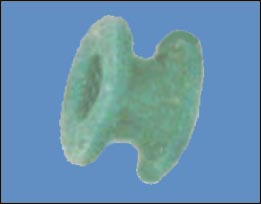
사진 62. 치료가 잘 되지 않는 삼출성 중이염은 고막 통기관 삽입수술로 치료할 수 있다. 외이도 내 공기와 중이 강 내 공기가 서로 잘 유통되면 삼출성 중이염이 더 잘 치료될 수 있다.
Copyright ⓒ 2013 John Sangwon Lee, M.D., FAAP
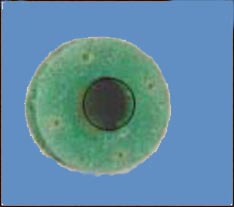
사진 63. 잘 치료되지 않는 삼출성 중이염을 치료할 때 쓸 수 있는 고막 통기관의 일종.
Copyright ⓒ 2013 John Sangwon Lee, M.D., FAAP
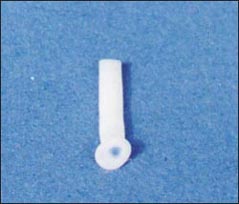
사진 64. 잘 치료되지 않는 삼출성 중이염을 치료할 때 쓰는 고막 통기관의 일종.
Copyright ⓒ 2013 John Sangwon Lee, M.D., FAAP
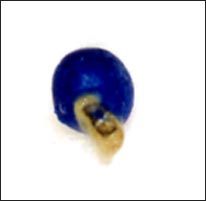
사진 65. 고막 통기관을 통해 중이 강 내에서 외이도 내로 흘러나온 고름.
Copyright ⓒ 2013 John Sangwon Lee, M.D., FAAP
- 풀같이 끈적끈적한 삼출액이 중이 강 속에 괴어 있는 중이염을 삼출성 중이염, 아교 귀, 장점액성 중이염, 또는 카타르성 중이염이라고 한다.
삼출성 중이염(아교 귀/장점액성 중이염)의 원인
- 알레르기성 비염이 있거나, 아데노이드가 비정상적으로 비대 되어 있거나 이관 입구에 있는 림프조직이나 아데노이드가 비정상적으로 비대 될 때, 또 이관염 등으로 이관이 쉽게 막힐 수 있다.
- 이 때 중이 강 내에 있던 공기가 중이의 점막을 통하여 전부 흡수되어 중이 강 내 압은 음압이 된다.
- 중이 강 내 압이 음압이 될 때 중이 강 내 정상적으로 차 있어야 할 공기 대신 풀같이 끈적끈적한 삼출액이 중이 강 내에 괴어 삼출성 중이염이 생긴다.
- 또 급성 중이염이나 재발성 중이염을 적절한 항생제로 적절히 치료해서 중이염을 일으켰던 중이 강 내 박테리아가 전부 박멸되어도 끈적끈적한 혈청 같은 삼출액이 중이 강 내에 괴어 삼출성 중이염이 될 수 있다.
- 급성 중이염을 적절한 항생제로 적절히 치료한 후 30일이 될 때까지 30% 정도에서 중이 강 내 무 균성 삼출액이 계속 남아 있을 수 있다고 한다.
삼출성 중이염(아교 귀/장점액성 중이염)의 증상 징후
- 삼출성 중이염의 정도에 따라 증상 징후가 다르다.
- 삼출성 중이염이 있으면 청력이 일부 또는 전부 일시적으로 또는 영구적으로 상실될 수 있고, 난청이 생길 수 있고 잘 들을 수 없다.
- 귀속에 압박감이 생길 수 있다.
- 입을 벌렸다 오므렸다 할 때 인두 강 내 공기가 이관 입구와 이관 속을 통해 중이 강 내로 들어갔다 나왔다 할 수 있다.
- 이 때 중이 강 속 압이 양압이 되었다 음압이 되었다 하면서 고막이 울려 뽀각뽀각 소리가 날 수 있다.
- 무균성 삼출성 중이염이 있는 아이들이 감기나 다른 종류의 바이러스성 상·하기도 염에 걸렸을 때 무균성 삼출성 중이염이 있는 중이 강 속 삼출성 점액에 박테리아 감염이 또다시 생기면 원래부터 있던 무균성 삼출성 중이염이 박테리아 급성 중이염으로 되기 쉽다.
- 그와 반대로 박테리아 급성 중이염을 적절히 치료해도 박테리아 급성 중이염이 다 나은 후 무균성 삼출성 중이염으로 이어질 수 있다.
- 또 그 무균성 삼출성 중이염이 다 낫기 전에 감기나 다른 종류의 바이러스성 상·하기도 염에 걸려 앓는 중 이차 박테리아 감염이 중이 강 속에 또 생기면 무균성 삼출성 중이염이 박테리아 급성 중이염으로 이어질 수 있다.
- 이와 같이 박테리아 급성 중이염이 무균성 삼출성 중이염으로, 무균성 삼출성 중이염이 박테리아 급성 중이염으로 계속 악순환 될 때도 있다.
- 기관지 천식, 아토피성 피부염, 알레르기성 비염 등 알레르기 질환을 가진 아이들에게 무균성 삼출성 중이염이 더 잘 생긴다.
삼출성 중이염(아교 귀/장점액성 중이염)의 진단
- 병력, 증상 징후와 진찰소견을 종합하여 진단한다.
- 이경으로 외이도 속을 통해 고막을 육안으로 직접 들여다보고 진단할 수 있다.
- 고실계측법(Tympanometry)검사로 얻은 고실도(Tympanogram) 결과로 중이 속에 삼출액이 있는지 알아볼 수 있다.
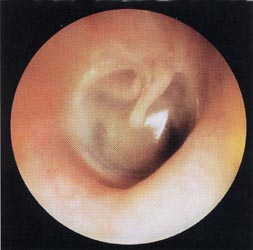
사진 66. 이경으로 외이도 속을 통해 육안으로 본 정상 고막.
출처- Otitis Media, Roche laboratories
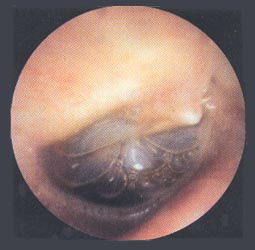
사진67. 삼출성 중이염이 있을 때 이경을 통해 육안으로 본 고막과 고막을 통해 본 중이강 속 삼출액이 차있고 공기 거품이 생겨있으며 삼출액 레벨이 보인다.
출처- Otitis Media, Roche laboratories
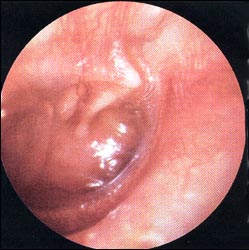
사진 68. 이경을 통해 육안으로 본 비정상 고막18.
삼출성 중이염으로 불투명하고 심히 위축된 오른쪽 고막.
출처- Otitis media, Roche laboratories
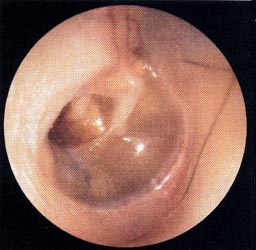
사진 69. 삼출성 중이염이 있을 때 이경을 통해 육안으로 본 비정상 오른쪽 고막.
중이 강 속에 삼출액이 차 있고 오른쪽 상부의 고막 부분이 심하게 위축되어 있고 삼출액 레벨이 보인다 18.
출처- Otitis Media, Roche laboratories
삼출성 중이염(아교 귀/장점액성 중이염)의 치료
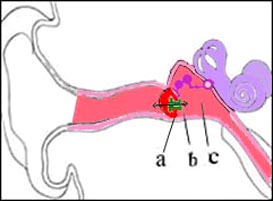
그림 70. 고막 통기관 삽입 치료.
a-고막, b-고막 통기관, c-중이강.
Copyright ⓒ 2011 John Sangwon Lee, M.D., FAAP
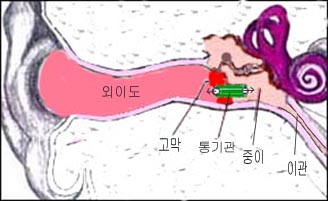
그림 71. 고막 통기관 삽입 치료.
고막, 고막 통기관, 중이강.
Copyright ⓒ 2011 John Sangwon Lee, M.D., FAAP
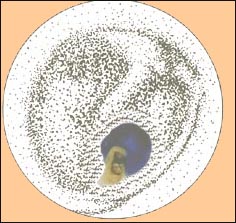
그림 72. 고막 통기관을 통해 나온 고름.
통기관으로 치료하는 동안에도 급성 중이염이생길 수 있다.
Copyright ⓒ 2011 John Sangwon Lee, M.D., FAAP
- 대부분의 무균성 삼출성 중이염은 아무 치료를 하지 않아도 3~8주 이내 자연히 낫을 수 있다.
- 그러나 무균성 삼출성 중이염을 일으킨 원인을 찾아 그 원인에 따라 치료해야 할 때도 많다.
- 때로는 무균성 삼출성 중이염과 박테리아 급성 중이염과 재발성 중이염을 확실히 감별 진단하기가 어렵다.
- 따라서 급성 중이염을 치료해 줄 때와 같이 무균성 삼출성 중이염을 적절한 항생제와 비강 점막 충혈 완화제 등으로 10~14일 간 치료한 다음 다시 따라잡기 진료를 받아서 완치됐는지 꼭 확인해야 한다.
- 적절한 경구용 항생제와 비강 점막 충혈 완화제 등으로 10~14일간 치료해 준 후에도 중이 강 속 무균성 삼출액이 계속 남아있으면 적절한 항생제로 또다시 10~14일간 더 치료해 주든지 항생제 치료를 더 이상 해 주지 않고 그냥 관찰적 치료를 해 볼 수 있다.
- 무균성 삼출액이 있다고 확실한 진단이 나면 항생제로 치료할 필요가 없다고 하는 의사들도 많다.
- 이렇게 항생제로 적절히 치료한 후나 항생제로 치료하지 않고 그냥 관찰적 치료를 한 후에도 중이 강 내 삼출액이 다 없어졌는지 추후 꼭 확인 진료를 받아야 한다.
- 비강 점막층이나 이관 점막층을 수축시키기 위해서 슈다페드 등의 비강점막 충혈 완화제로 치료할 수 있다.
- 이관이 붓는 것을 치료하기 위해 코르티코스테로이드제 코 분무로 4~8주 동안 비강 내에 뿌려 치료할 수도 있다.
- 이런 치료에 관해 찬반이 있다.
- 앞서 설명한 여러 종류의 방법으로 치료해도 삼출성 중이염이 잘 낫지 않고 중이 강 내 삼출액이 계속 괴어 있으면 중이 강 내와 외이도 내 공기가 서로 유통되도록 조그마한 고막 통기관(사진 64 참조)을 고막에 끼는 수술 치료를 받아야 한다.
- 고막에 통기관을 낀 후 몇 개월 내지 1~2년 이내 통기관이 자연히 빠져나올 수 있다.
- 또 고막 통기관 삽입 치료를 받고 있는 동안에도 무균성 삼출성 중이염이나 급성 중이염이 다시 생기든지 고막 통기관 자체로 인해 부작용이 생길 때는 고막 통기관을 수술로 제거 할 때도 있다.
- 그렇지만 고막에 통기관을 끼워 둔 채로 몇 개월 동안 기다리면 거의 대부분의 경우 삼출성 중이염은 쉽게 치료된다. 그러나 이 치료도 단점이 많이 있다.
- 최근 연구에 의하면 통기관을 고막에 끼는 치료를 받은 후 고막이 위축될 수 있고, 청력장애가 생길 수 있으며 심지어는 청력이 완전히 상실될 수 있다고 해서 통기관 장치 치료는 될 수 있는 한 최종 선택 치료 방법이어야 한다.
- 그러나 재발성 급성 중이염과 삼출성 중이염을 고막 통기관 삽입으로 치료 받은 아이들을 4년 동안 추적치료 연구결과에는 통기관 삽입으로 치료받은 아이들의 청력은 재발성 급성 중이염과 삼출성 중이염을 통기관 삽입으로 치료받지 않은 아이들의 청력에 비해서 정상이거나 거의 정상이었다.
- 즉 위 두 가지 치료방법에서 청력에 다른 점이 없다고 한다.1
- 고막 통기관 삽입 치료를 받은 후 고막 통기관 삽입을 했던 고막 부분에 육아종이 생길 수 있다. 그런 육아종은 Ciprofloxacin/Dexamethasone 귀 점적약제로 치료할 때 치료효과가 단순히 항생제 귀 점적약제로 치료받을 때보다 효과가 월등히 좋다고 한다. 출처 9
- 무균성 삼출성 중이염을 항생제, 비강 점막 충혈 완화제, 항히스타민제, 코 속 코르티코스테로이드 분무제 등으로 4~8주 동안 적절히 치료해도 중이 강 내 삼출액이 계속 남아있고 난청이 생길 때는 이비인후과 전문의에게 문의해서 적극적으로 치료 받아야 한다.
- 이런 때는 통기관을 고막에 끼워 치료해 주어야 한다고 권장하는 의사들이 더 많다.
- 어떤 경우에는 무균성 삼출성 중이염을 치료하기 위해서 비대 아데노이드 절제 수술치료를 하기도 한다.
- 그렇지만 아데노이드 절제 수술로 떼어 낸 후에도 삼출성 중이염이 완치되지 않을 수 있다.
- 아데노이드 적제 수술치료를 받았다고 해서 무균성 삼출성 중이염이나 재발성 중이염 또는 급성 중이염이 재발하는 것을 완전히 예방할 수 없다.
- 무균성 삼출성 중이염을 간트리신이나 아목시실린 또는 그 외 다른 종류의 항생제를 매일 1~2회 1~ 2개월 동안 복용해서 급성 중이염이나 급성 중이염이 삼출성 중이염으로 되는 것을 예방적 치료 해주기도 한다.
- 알레르기성 비염과 무균성 삼출성 중이염을 동시 치료할 때에는 알레르기성 질환을 잘 일으킬 수 있는 우유나 우유 단백질이 든 음식물을 섭취하지 않는 것도 고려해야 한다.
- 또 알레르기성 비염을 유발 시킬 수 있는 각종 항원에 노출되지 않게 피하거나 항원을 제거한다.
- 그렇지만 알레르기 질환을 잘 일으키는 음식물을 피해서 치료하는 데에 대해서 찬반론이 있다. 적어도 몇 주 동안 알레르기 질환을 잘 유발 시킬 수 있는 음식물을 일절 주지 말고 또 여러 종류의 항원에 노출되지 않게 해서 무균성 삼출성 중이염을 예방 치료 해보는 것이 바람직하다.
|
다음은 “삼출성 중이염과 폐 석회결절이 어떤 건가요?”에 관한 인터넷 소아청소년 건강상담 질의응답의 예 입니다. |
Q&A. 삼출성 중이염과 폐 석회결절이 어떤 건가요?
Q.
- 안녕하세요. 아이가 7살 남자아이에요. 4살 말부터 삼출성 중이염에 걸려서 5살부터 1년에 한 번꼴로 환기관 삽입 수술을 받았어요. 이번에도 또 하게 되는데 3번째구요. 작년에는 아데노이드 제거 수술도 같이 받았구요. 두 가지 여쭤 볼게요. 가장 걱정되는 건 청력이에요. 고막을 자주 건드리니까 걱정이 되어서요. 환기관수술을 제때에 안 해서 오랫동안 삼출성 중이염이 방치되면 청력이 떨어진다는 말도 있구요. 수술을 너무 자주 해주어서 고막에 문제가 생겨 청력이 떨어진다는 말도 있는데. 어느 말을 들어야할까요? 물이 차면 잘 못 들으니까 항생제를 쓰다가, 수술을 하게 되는 건데.. 괜찮을는지요? 두 번째는요 이번에 수술하려고 엑스레이 검사를 받았는데요. 오른쪽 폐부분에 석회결절이 있다네요. 수술에 별 문제는 없을 것 같은데, 소아청소년과 에서 진단을 받고 오라고 하거든요. 석회결절이 무엇이며, 해로운 건지. 어떻게 해야하는 건지 좀 알려주세요. 답변 기다리겠습니다. 수고하세요.
A.
- 수맘께
- 안녕하세요. 갑자기 생긴 집안 일로 답변이 늦어 죄송합니다. 이미 답변을 얻으셨으리라 믿습니다. 늦게라도 답변을 드립니다.
- 삼출성 중이염은 알레르기성 비염을 가지고 있는 아이들에게 더 잘 생길 수 있습니다.
- 알레르기 질환을 예방하고 치료하기 위해 환경 정리, 항히스타민제 치료, 코르티코스테로이드제 치료, 항생제 예방적 치료, 아데노이드 절제 수술, 환기 관(통기관) 삽입수술, 관찰적 치료 등 한 가지 또는 여러 가지를 겸해서 삼출성 중이염을 치료합니다.
- 삼출성 중이염을 적절히 치료하지 않으면 급성 중이염 또는 재발성 중이염이 생길 수 있고 청력장애가 생길 수 있습니다.
- 또 삼출성 중이염을 통기관 삽입 수술로 치료 하면 고막 상흔이 생길 수 있고 또는 중이강 손상이 수술로 생길 수 있습니다.
- 통기관 삽입 장치로 인해 고막염 또는 중이염 등이 생길 수도 있습니다.
- 따라서 통기관 삽입수술로 고막 손상과 상흔이 생기고 청력 장애가 생길 수 있습니다.
- 여기서 삼출성 중이염을 아무 치료를 하지 않고 그대로 관찰적 치료, 약물치료, 또는 통기관 삽입 수술치료 중 어떤 종류의 치료를 선택해야 하는지에 관해서는 의사, 환자, 보호자가 한참동안 앉아서 상담한 후 선택해야 합니다.
- 폐에 칼슘이 침착되어 생기는 현상을 석회화라고 하는 것 같습니다.
- 그 원인은 여러 가지이지만 폐결핵으로 생기는 경우도 있습니다.
- 보통 잠재성 폐결핵을 앓은 후 생긴 상흔에 칼슘이 침착될 수 있습니다.
- 삼출성 주이염, 폐결핵을 참조하시기 바랍니다.
- 질문이 더 있으면 다시 연락해 주시기 바랍니다.
- 감사합니다. 이상원 드림
|
다음은 “중이염과 삼출성 중이염”에 관한 인터넷 소아청소년 건강상담 질의응답의 예 입니다. |
Q&A. 중이염과 삼출성 중이염
Q.
- 저의 아이는 15개월이 되었어요. 밥도 잘 먹고 비교적 건강한 여자아이입니다.
- 지난달 4월30일경 밤에 보채어 병원 응급실을 갔더니 중이염 (오른쪽)이라 하여 외래 이비인후과에서 진료보고 약을 하루먹자 설사를 하여 집 가까운 이비인후과에 갔습니다.
- 거기서 세파쿨러라는 항생제 치료를 그때부터 2주정도 했는데 의사 말이 조금씩 밖에 나아지질 않는다며 옴니세프로 항생제를 교체하고 하루 먹이니 아이가 빨간 설사를 하였어요. 그러자 3일간 중지하였고 록시그란 이란 항생제로 바꾸어 주었어요. 항생제를 잠시 중지했던 3일간 사이에 감기가 걸려 후두염까지 되어 아이가 무척 힘들어하여 분당00병원 응급실로가 치료를 하고 다음날부터 소아청소년과 를 다니면서 오구멘틴 을 또 2주 정도 썼어요.
- 이후 또 세프템 건조시럽을 또 일주일 썼어요.
- 그래도 중이염이 나아지질 않았다고 소아청소년과 에서는 바난 건조시럽을 일주일 처방을 내주었어요. 저는 이제 약을 먹이기가 정말로 아이도 약을 먹이고 나면 얼굴이 하얗게 되면서 힘들어해요. 같은 병원 이비인후과 진료를 보았어요(소아청소년과 에서 청력 검사를 해 보라 하여) 이비인후과 의사는 항생제를 먹을 만큼 너무 많이 먹었으니 중지 해보자 합니다. 그러나 귀의 중이염은 아직 있다고 합니다.
- 저는 약을 계속 먹이자니 내성 같은 문제도 걱정이고 안 먹이자니 중이염이 심해질까 걱정이고 정말 어느 과 선생님 말을 들어야 할지 고민입니다.
- 아이는 지금은 잘 먹고 감기증상도 없어요.
- 약을 안 먹이고 있으면 어떻게 되나요? 또 점점 강한 항생제를 많이 먹이면 이로 인해 우리아이가 또 다른 문제가 생기질 않을까요?
- 어떻게 해야 우리아이에게 가장 좋은 방법인지 정말 갈등입니다. 선생님 아이라 생각하시고 좋은 방안을 가르쳐 주세요.
A.
- 현숙님
- 안녕하십니까. 좋은 질문해 주셔서 감사합니다.
- 자녀의 나이와 성별, 과거 현재 가족의 병력, 증상 징후와 진찰소견, 적절한 임상검사 등의 결과를 종합해서 진단 치료하는 것이 이상적이지만 주신 정보를 참작해서 답변을 드립니다.
- 환자를 치료할 때는 항시 내 몸과 내 자식의 병을 치료하는 것 같이 해야 하지요.
- 자식이 빵을 달라고 할 때 돌을 주지 않고 생선을 달라고 할 때 독사를 주지 않습니다.
- 상당히 혼동되시겠습니다.
- 아시겠지만 우리 소아청소년과 의사들은 거의 매일 빼놓지 않고 볼 수 있는 병이 소아 중이염입니다.
- 소아 중이염의 원인 증상 징후 진단 치료는 p.00 급성 중이염, p.00 재발성 중이염, p.00 만성 중이염, p.00 삼출성 중이염 등을 참조하시기를 바랍니다.
- 박테리아 급성 중이염은 경구용 아목시실린(Amoxillin)으로 약 10일 간 치료받은 다음 다시 추적 진찰을 받고 완치 되지 않으면 오그멘틴(Augmentin) 등으로 2차 항생제 치료로 약 10일간 치료하는 것이 일반적인 요즘 치료 방법입니다.
- 그러나 환아가 사는 나라에 따라 지역에 따라, 그동안 중이염을 치료했을 때 치료효과 등 단골의사의 경험에 따라 1차적 또는 2차적 중이염 치료 선택 항생제의 종류는 다를 수 있습니다.
- 페니실린에 알레르기가 있는 환아의 급성 중이염을 1차적으로 세파크롤(Cefaclor), Cefuroxime 또는 다른 항생제들 중 한 종류를 우선 선택해서 치료합니다.
- 이런 식으로 소아 박테리아 급성 중이염을 치료하면 치료가 잘 되는 것이 보통입니다.
- 드물게는 급성 중이염을 치료한 후 무균성 삼출성 중이염이 생길 수 있습니다. 이때는 치료 방법이 다소 복잡해집니다.
- 무균성 삼출성 중이염의 정도에 따라 2~8주 동안 아무 약물도 치료하지 않고 관찰적 치료만 하고 그 동안 한두 번 정도 그 경과가 어떤지 추적 진찰을 받기도 합니다.
- 대부분의 무균성 삼출성 중이염은 자연히 낫습니다.
- 때로는 무균성 삼출성 중이염이 낫지 않고 청력이 감소되기도 합니다.
- 이때는 이비인후과 전문의가 고막에 통기관을 꼽는 수술을 하기도 합니다.
- 그 수술 시기는 그때그때에 따라 다릅니다.
- 아마도 지금 자녀의 중이염은 무균성 삼출성 중이염 상태에 있다고 생각됩니다.
- 따라서 항생제로 치료하지 말고 관찰적 치료만 하시고 2~3주 후 무균성 삼출액이 중이강 속에서 다 없어졌는지 확인하는 정도 추적 치료를 하면 된다고 생각됩니다.
- 관찰은 상당히 좋은 치료 방법의 하나입니다.
- 연구에 의하면 급성 중이염을 항생제로 적절히 치료한 후 30일 경 중이염 환자의 30% 에서 중이 강 내에 무균성 삼출액이 그냥 남아 있을 수 있고 또 90일 후 약 10%에서 중이 강 내 무균성 삼출액이 남아 있을 수 있다고 합니다.
- 급성 중이염을 적절히 치료한 후에도 중이 강 내에 무균성 삼출액이 오랫동안 남아 있을 수 있다는 연구입니다.
- 이런 경우 대부분은 알레르기성 비염이나 기관지 천식 등 알레르기성 질환을 함께 가지고 있습니다.
- 무균성 삼출성 중이염을 가진 아이들의 아데노이드가 커져 있을 수 있습니다.
- 그래서 알레르기성 비염을 동시 치료하는 경우도 많습니다.
- 오늘은 이 정도로 말씀드리겠습니다.
- 단골소아청소년과 의사 선생님의 계속적인 치료를 받으시기 바랍니다.
- 질문이 더 있으면 또 방문하세요. 감사합니다. 이상원 드림
Serous otitis media (Secretory otitis media/Glue ear)

Photo 62. Otitis media with effusion, which is not well treated, can be treated with tympanic ventilator implantation surgery. Otitis exudative otitis media can be treated better if the air in the outer ear canal and the air in the middle ear cavity flow well with each other. Copyright ⓒ 2013 John Sangwon Lee, M.D., FAAP

Photo 63. A type of tympanic ventilator that can be used to treat poorly treated otitis media with effusion. Copyright ⓒ 2013 John Sangwon Lee, M.D., FAAP

Picture 64. A type of tympanic ventilator used to treat poorly treated otitis media with effusion. Copyright ⓒ 2013 John Sangwon Lee, M.D., FAAP

Photo 65. Pus flowing from the middle ear cavity into the ear canal through the tympanic duct. Copyright ⓒ 2013 John Sangwon Lee, M.D., FAAP
• Otitis media with a sticky, sticky exudate stagnant in the middle ear cavity is called otitis media with effusion, glue ear, intestinal mucous otitis media, or catarrhal otitis media.
Causes of otitis media with effusion (glia/intestinal mucous otitis media)
• When you have allergic rhinitis, abnormally enlarged adenoids, or abnormally enlarged lymphatic tissue or adenoids at the entrance of the eustachian tube, the eustachian tube may be easily blocked due to otitis externa.
• At this time, all the air in the middle ear cavity is absorbed through the mucous membrane of the middle ear, and the pressure in the middle ear cavity becomes negative pressure.
• When the pressure in the middle ear cavity becomes negative pressure, a sticky exudate-like glue accumulates in the middle ear cavity instead of the normally filled air in the middle ear cavity, causing otitis media with effusion.
• In addition, even if all the bacteria in the middle ear cavity that caused otitis media are completely eradicated by properly treating acute otitis media or recurrent otitis media with appropriate antibiotics, a sticky serum-like exudate may accumulate in the middle ear cavity and become otitis media with effusion.
• It is said that sterile effusion in the middle ear cavity can remain in about 30% of cases until 30 days after acute otitis media is properly treated with appropriate antibiotics.
Signs, symptoms of otitis media with effusion (glia/intestinal mucous otitis media)
• Symptoms differ depending on the severity of otitis media with effusion.
• With otitis media with effusion, you may lose some or all of your hearing temporarily or permanently, and you may have hearing loss and difficulty hearing.
• You may feel pressure in your ears.
• When you open and close your mouth, the air in the pharyngeal cavity enters and exits the middle ear cavity through the entrance of the ear canal and the inside of the ear canal.
• At this time, the eardrum may sound, saying that the pressure in the middle ear has changed from positive pressure to negative pressure.
• When children with aseptic otitis media have a cold or other viral upper respiratory tract infections. If another bacterial infection of the exudative mucus in the middle ear cavity with sterile otitis media occurs again, the original sterile otitis media with effusion is replaced by bacteria. prone to acute otitis media.
• Conversely, even adequate treatment of acute bacterial otitis media can lead to aseptic otitis media with effusion after the bacterial acute otitis media has cleared.
• Also, if secondary bacterial infection occurs in the middle ear cavity while suffering from a cold or other viral upper respiratory tract infections before the aseptic otitis media has healed, aseptic otitis media with effusion can lead to bacterial acute otitis media.
• As described above, sometimes bacterial acute otitis media becomes aseptic otitis media with effusion, and aseptic otitis media with effusion continues into a vicious cycle of bacterial acute otitis media.
• Children with allergic diseases such as bronchial asthma, atopic dermatitis, and allergic rhinitis are more likely to develop aseptic otitis media.
Diagnosis of otitis media with effusion (glia/intestinal mucous otitis media)
• Diagnosis is made by combining medical history, symptoms, signs and examination findings.
• Diagnosis can be made by directly looking into the eardrum through the otoscope through the ear canal.
• A tympanogram obtained by tympanometry can determine whether there is effusion in the middle ear.

Photo 66. Normal tympanic membrane is seen through the otoscope through the external auditory meatus. Source- Otitis Media, Roche laboratories

Picture 67. In the presence of otitis media with effusion, the tympanic membrane seen through the otoscope and the middle ear cavity seen through the tympanic membrane are filled with exudate, air bubbles are formed, and the exudate level is visible. Source- Otitis Media, Roche laboratories

Picture 68. Abnormal tympanic membrane is seen with the naked eye through the otoscope18. Opaque and severely atrophied right eardrum due to otitis media with effusion. Source- Otitis media, Roche laboratories

Photo 69. Abnormal right tympanic membrane is seen through the otoscope in the presence of otitis media with effusion. The middle ear cavity is filled with exudate, the upper right eardrum is severely atrophied, and the level of exudate is visible 18. Source- Otitis Media, Roche laboratories
Treatment of otitis media with effusion (glia/intestinal mucous otitis media)

Figure 70. Typhoid ventilator implantation treatment. a – tympanic membrane, b – tympanic cavity, c – middle ear cavity. Copyright ⓒ 2011 John Sangwon Lee, M.D., FAAP

Figure 71. The treatment of tympanic tube insertion. the tympanic membrane, tympanic duct, middle ear cavity. Copyright ⓒ 2011 John Sangwon Lee, M.D., FAAP

Figure 72. Pus from the tympanic duct. Acute otitis media may also occur during treatment with a ventilator. Copyright ⓒ 2011 John Sangwon Lee, M.D., FAAP
• Most aseptic otitis media with effusion can resolve spontaneously within 3 to 8 weeks without any treatment.
• However, it is often necessary to find the cause of aseptic otitis media with effusion and treat it according to the cause. • Sometimes it is difficult to make a definitive differential diagnosis between aseptic otitis media with effusion and bacterial acute otitis media with recurrent otitis media.
• Therefore, as in the treatment of acute otitis media, aseptic otitis media with effusion should be treated for 10 to 14 days with appropriate antibiotics and nasal mucosal decongestants, and then receive a follow-up treatment to check if there is a cure.
• If sterile effusion remains in the middle ear cavity after 10 to 14 days of treatment with appropriate oral antibiotics and nasal mucosal decongestants, treat with appropriate antibiotics for another 10 to 14 days or without further antibiotic treatment. You can just do the observational treatment.
• Many doctors say that antibiotics are not necessary once a definitive diagnosis of sterile exudate is established.
• After proper treatment with antibiotics or just observational treatment without antibiotics, be sure to check and see if the effusion in the middle ear is completely gone.
• It can be treated with nasal mucosal decongestants, such as Sudafed, to contract the nasal mucosa or ductal mucosa. • To treat swelling of the ear canal, nasal sprays of corticosteroids may be administered intranasally for 4 to 8 weeks.
• There are pros and cons to this treatment.
• If otitis media with effusion does not heal well even after treatment with the various methods described above, and the effusion in the middle ear cavity continues to accumulate, a small tympanic ventilation tube (see photo 64) is inserted into the tympanic membrane so that air in the middle ear cavity and external auditory canal circulate. should get
• After a vent is placed on the eardrum, the vent may come out spontaneously within a few months to 1 to 2 years. • In some cases, the tympanic tube is surgically removed when aseptic otitis media with effusion or acute otitis media reoccurs or side effects occur due to the tympanic tube itself while receiving treatment with the tympanic tube.
• However, in most cases, otitis media with effusion can be easily treated by waiting several months with a vent tube in the eardrum. However, this treatment also has many drawbacks.
• Recent studies suggest that eardrum atrophy, hearing loss, and even complete hearing loss after tympanic membrane therapy have been shown, so ventilator therapy should be the last resort if possible.
• However, the results of a 4 year follow-up study of children treated for recurrent acute otitis media and otitis media with effusion by tympanic tube insertion showed that the hearing of children treated with ventilation tube insertion was not significantly affected by recurrent acute otitis media and otitis media with effusion. was normal or nearly normal compared to the hearing of • In other words, there is no difference in hearing between the two treatment methods.1
• After receiving tympanic tube insertion treatment, granulomas may develop in the area of the eardrum where the tympanic tube was inserted. When such granulomas are treated with Ciprofloxacin/Dexamethasone ear drops, the therapeutic effect is much better than when treated with simple antibiotic ear drops. Source 9
• If effusion in the middle ear remains and hearing loss occurs after adequate treatment for aseptic otitis media with antibiotics, nasal mucosal decongestants, antihistamines, and nasal corticosteroid sprays for 4 to 8 weeks, contact an otolaryngologist and action should be treated
• In this case, more doctors recommend that a ventilation tube be inserted into the eardrum for treatment.
• In some cases, hypertrophic adenoid excision surgery is used to treat aseptic otitis media with effusion.
• However, otitis media with effusion may not be cured even after adenoidectomy is performed.
• Recurrence of aseptic otitis media with effusion, recurrent otitis media, or acute otitis media cannot be completely prevented even if adenoids are administered surgically.
• For aseptic otitis media with otitis media, prophylactic treatment of acute otitis media or acute otitis media with effusion is possible by taking gantrisin, amoxicillin, or other antibiotics 1 to 2 times daily for 1 to 2 months.
• When treating allergic rhinitis and aseptic otitis media at the same time, it is also important to consider avoiding the consumption of milk or foods containing milk protein, which can cause allergic diseases.
• Avoid exposure to various antigens that can cause allergic rhinitis or remove antigens.
• However, there are pros and cons to avoiding foods that are prone to allergic diseases. It is desirable to prevent and treat aseptic otitis media for at least a few weeks by not giving any food that can cause allergic diseases and not being exposed to various types of antigens.
The following is an example of Internet Child and Adolescent Health Counseling Questions and Answers on “What is otitis media with effusion and calcified pulmonary nodules?”
Q&A. What are otitis media with effusion and pulmonary calcific nodules?
Q.
• Good morning. The child is a 7-year-old boy. He suffered from otitis media with effusion at the end of the age of 4, and since the age of 5, he underwent ventilator implantation once a year. This is the third time I’m doing it again. Last year, I also had an adenoid removal surgery. Let me ask you two questions.
My biggest concern is hearing. I’m worried because I often touch my eardrums. There is also a saying that if the otitis media with effusion is left unattended for a long time because ventilation tube surgery is not performed on time, the hearing will deteriorate. There is a saying that there is a problem with the eardrum due to the operation being performed too often, causing hearing loss. Which one should I listen to? I can’t hear well when the water is full, so I’m using antibiotics, and then I’m going to have surgery…
Will it be okay? The second time. This time, I had an X-ray examination for surgery. I have a calcific nodule in my right lung. I don’t think there will be any problems with the surgery, but the Pediatrics Department tells me to come and get a diagnosis. What is lime nodule and is it harmful? Please tell me what to do. Answers I’ll wait. work hard.
A.
• Sumam • Good morning. Sorry for the late reply due to sudden housework. I’m sure you’ve already got the answer. I will reply even if it is late.
• Otitis media with effusion is more likely to occur in children with allergic rhinitis.
• For the prevention and treatment of allergic diseases, one or more combinations of exudative treatment such as environmental cleanup, antihistamine treatment, corticosteroid treatment, antibiotic prophylactic treatment, adenoid excision operation, ventilation tube (ventilation duct) insertion surgery, observational treatment, etc. It treats otitis media.
• If otitis media with effusion is not properly treated, acute or recurrent otitis media may develop and may lead to hearing loss.
• In addition, if otitis media with effusion is treated with venting surgery, scarring of the eardrum may occur or damage to the middle ear cavity may result from surgery.
• The ventilator can also cause tympanitis or otitis media.
• Therefore, ventilatory tube insertion surgery may cause damage and scarring of the eardrum, as well as hearing impairment.
• For otitis media with effusion, as to which type of treatment to choose: observational treatment, drug treatment, or surgical treatment with a vent tube without any treatment, the doctor, patient, and guardian should sit and consult for a long time before making a choice.
• A phenomenon caused by calcium deposits in the lungs seems to be called calcification.
• There are many causes, but sometimes it is caused by pulmonary tuberculosis.
• Calcium deposits may occur in scars, usually after having latent pulmonary tuberculosis.
• See otitis exudative, pulmonary tuberculosis.
• If you have more questions, please contact us again.
• Thank you. Lee Sang-won.
The following is an example of Internet pediatric health counseling Q&A regarding “otitis media and otitis media with effusion”.
Q&A. Otitis media and otitis media with effusion
Q.
• My child is 15 months old. She eats well and is a relatively healthy girl.
• When I went to the hospital emergency room at night around April 30 last month, I was diagnosed with otitis media (right), so I went to the outpatient otolaryngology department for treatment. After taking medicine for a day, I got diarrhea and went to the otolaryngology department near my house.
• There, she was treated with an antibiotic called Cefa Cooler for about 2 weeks, and the doctor said that she only got better little by little, so she replaced the antibiotic with Omni Cebu and fed it for a day, and the child had red diarrhea. Then she stopped for 3 days and switched to an antibiotic called Roxy Gran. During the 3 days when I stopped taking antibiotics for a while, I caught a cold and even had laryngitis, and the child was having a very difficult time. The emergency room at Bundang 00 Hospital was treated, and from the next day, I went to the pediatrician and took Augmentin for another 2 weeks.
• After that, she used Ceftem Dry Syrup for another week.
• Even so, otitis media did not improve, so the pediatrician prescribed Banan dry syrup for a week. I’m really struggling with medication now as her face turns white after she’s given the pills. I went to the otolaryngology department at the same hospital (the pediatrician asked me to do a hearing test) and the otolaryngologist told me to stop taking antibiotics because I ate too much. However, otitis media is still present.
• I’m worried about problems like tolerance if I keep taking the medicine, I’m worried that otitis media will get worse if I don’t take it, and I’m really worried about which department to listen to.
• The child is now eating well and has no symptoms of a cold.
• What if I don’t take my medication? Also, if I feed more and more strong antibiotics, won’t this cause another problem for my child?
• I’m really conflicted about what to do in the best way for my child. Please think of me as a teacher and teach me a good way. A.
• Hyunsook • Hello. Thanks for the nice question.
• Ideally, diagnosis and treatment should be performed by combining the results of the child’s age and gender, past and present family history, symptom signs and examination findings, and appropriate clinical tests, but we will respond taking into account the information you have given us.
• When treating a patient, I should always treat my body and my children’s diseases as if they were being treated.
• Don’t give stones when your child asks for bread and no snakes when he asks for fish.
• You must be quite confused.
• As you know, otitis media in children is a disease that we pediatricians see almost every day.
• For the causes, symptoms, symptoms, and treatment of otitis media in children, refer to p.00 acute otitis media, p.00 recurrent otitis media, p.00 chronic otitis media, and p.00 otitis media with effusion.
• Bacterial acute otitis media is treated with oral amoxicillin for about 10 days, then follow-up again and, if not cured, treatment with secondary antibiotics such as Augmentin for about 10 days is a common treatment these days. .
• However, the type of antibiotic selected for primary or secondary otitis media may be different depending on the country where the child lives, depending on the region, and the experience of the regular doctor, such as the therapeutic effect when treating otitis media.
• Acute otitis media in children allergic to penicillin is treated with Cefaclor, Cefuroxime, or one of the other antibiotics first.
• Treatment of acute bacterial otitis media in children in this way is usually successful.
• Rarely, aseptic otitis media with effusion may develop after treatment for acute otitis media. In this case, the treatment method becomes somewhat complicated.
• Depending on the severity of aseptic otitis media with effusion, observational treatment is performed without any medication for 2 to 8 weeks, followed by follow-up once or twice during that time.
• Most cases of aseptic otitis media with effusion go away on their own.
• Occasionally, aseptic otitis media with effusion does not go away and there is hearing loss.
• In this case, an otolaryngologist may perform an operation to insert a ventilation tube into the eardrum.
• The timing of the operation varies from time to time.
• Perhaps your child now has otitis media with sterile otitis media with effusion.
• Therefore, do not treat with antibiotics, do only observational treatment, and after 2-3 weeks, follow-up treatment is enough to check whether the sterile exudate is completely gone in the middle ear cavity.
• Observation is a very good treatment method.
• According to a study, sterile effusion may remain in the middle ear cavity in 30% of otitis media patients within 30 days after adequate antibiotic treatment for acute otitis media, and sterile effusion in the middle ear cavity after 90 days in about 10%. say there may be.
• A study showing that sterile exudate may remain in the middle ear cavity for a long time even after adequate treatment of acute otitis media.
• Most of these cases also have allergic diseases such as allergic rhinitis or bronchial asthma.
• Children with aseptic otitis media with effusion may have enlarged adenoids.
• For this reason, allergic rhinitis is often treated simultaneously.
• Today, I will tell you this much.
• Please continue to receive treatment from a regular pediatrician.
• Come back with more questions. Thank you. Lee Sang-won Dream
출처 및 참조 문헌 Sources and references
- NelsonTextbook of Pediatrics 22ND Ed
- The Harriet Lane Handbook 22ND Ed
- Growth and development of the children
- Red Book 32nd Ed 2021-2024
- Neonatal Resuscitation, American Academy of Pediatrics
- www.drleepediatrics.com 제1권 소아청소년 응급 의료
- www.drleepediatrics.com 제2권 소아청소년 예방
- www.drleepediatrics.com 제3권 소아청소년 성장 발육 육아
- www.drleepediatrics.com 제4권 모유,모유수유, 이유
- www.drleepediatrics.com 제5권 인공영양, 우유, 이유식, 비타민, 미네랄, 단백질, 탄수화물, 지방
- www.drleepediatrics.com 제6권 신생아 성장 발육 육아 질병
- www.drleepediatrics.com제7권 소아청소년 감염병
- www.drleepediatrics.com제8권 소아청소년 호흡기 질환
- www.drleepediatrics.com제9권 소아청소년 소화기 질환
- www.drleepediatrics.com제10권. 소아청소년 신장 비뇨 생식기 질환
- www.drleepediatrics.com제11권. 소아청소년 심장 혈관계 질환
- www.drleepediatrics.com제12권. 소아청소년 신경 정신 질환, 행동 수면 문제
- www.drleepediatrics.com제13권. 소아청소년 혈액, 림프, 종양 질환
- www.drleepediatrics.com제14권. 소아청소년 내분비, 유전, 염색체, 대사, 희귀병
- www.drleepediatrics.com제15권. 소아청소년 알레르기, 자가 면역질환
- www.drleepediatrics.com제16권. 소아청소년 정형외과 질환
- www.drleepediatrics.com제17권. 소아청소년 피부 질환
- www.drleepediatrics.com제18권. 소아청소년 이비인후(귀 코 인두 후두) 질환
- www.drleepediatrics.com제19권. 소아청소년 안과 (눈)질환
- www.drleepediatrics.com 제20권 소아청소년 이 (치아)질환
- www.drleepediatrics.com 제21권 소아청소년 가정 학교 간호
- www.drleepediatrics.com 제22권 아들 딸 이렇게 사랑해 키우세요
- www.drleepediatrics.com 제23권 사춘기 아이들의 성장 발육 질병
- www.drleepediatrics.com 제24권 소아청소년 성교육
- www.drleepediatrics.com 제25권 임신, 분만, 출산, 신생아 돌보기
- Red book 29th-31st edition 2021
- Nelson Text Book of Pediatrics 19th- 21st Edition
- The Johns Hopkins Hospital, The Harriet Lane Handbook, 22nd edition
- 응급환자관리 정담미디어
- Pediatric Nutritional Handbook American Academy of Pediatrics
- 소아가정간호백과–부모도 반의사가 되어야 한다, 이상원 저
- The pregnancy Bible. By Joan stone, MD. Keith Eddleman, MD
- Neonatology Jeffrey J. Pomerance, C. Joan Richardson
- Preparation for Birth. Beverly Savage and Dianna Smith
- 임신에서 신생아 돌보기까지. 이상원
- Breastfeeding. by Ruth Lawrence and Robert Lawrence
- Sources and references on Growth, Development, Cares, and Diseases of Newborn Infants
- Emergency Medical Service for Children, By Ross Lab. May 1989. p.10
- Emergency care, Harvey Grant and Robert Murray
- Emergency Care Transportation of Sick and Injured American Academy of Orthopaedic Surgeons
- Emergency Pediatrics A Guide to Ambulatory Care, Roger M. Barkin, Peter Rosen
- Quick Reference To Pediatric Emergencies, Delmer J. Pascoe, M.D., Moses Grossman, M.D. with 26 contributors
- Neonatal resuscitation Ameican academy of pediatrics
- Pediatric Nutritional Handbook American Academy of Pediatrics
- Pediatric Resuscitation Pediatric Clinics of North America, Stephen M. Schexnayder, M.D.
-
Pediatric Critical Care, Pediatric Clinics of North America, James P. Orlowski, M.D.
-
Preparation for Birth. Beverly Savage and Dianna Smith
-
Infectious disease of children, Saul Krugman, Samuel L Katz, Ann A.
- 제4권 모유, 모유수유, 이유 참조문헌 및 출처
- 제5권 인공영양, 우유, 이유, 비타민, 단백질, 지방 탄수 화물 참조문헌 및 출처
- 제6권 신생아 성장발육 양호 질병 참조문헌 및 출처
- 소아과학 대한교과서
-
제18권 소아청소년 이비인후과 질환 참조문헌 및 출처
-
Emergency Care Transportation of Sick and Injured American Academy of Orthopaedic Surgeons
-
Emergency Pediatrics A Guide to Ambulatory Care, Roger M. Barkin, Peter Rosen
-
Gray’s Anatomy
-
Habilitation of The handicapped Child, The Pediatric Clinics of North America, Robert H Haslam, MD.,
-
Pediatric Otolaryngology Sylvan Stool
-
Hearing Loss In children, The Pediatric Clinics of North America Nancy Roizen,MD and Allan O Diefendorf, PhD
-
Recent Advances in Pediatric otolaryngology The Pediatric Clinics of North America
-
Pediatric Otolaryngology. The Pediatric Clinics of North America, David Tunkel, MD., Kenneth MD Grundfast, MD
Copyright ⓒ 2014 John Sangwon Lee, MD., FAAP
“부모도 반의사가 되어야 한다”-내용은 여러분들의 의사로부터 얻은 정보와 진료를 대신할 수 없습니다.
“The information contained in this publication should not be used as a substitute for the medical care and advice of your doctor. There may be variations in treatment that your doctor may recommend based on individual facts and circumstances.
“Parental education is the best medicine.